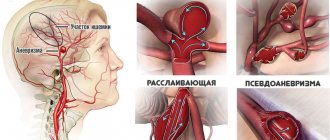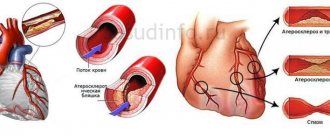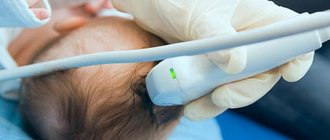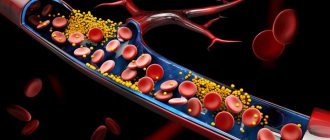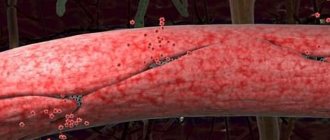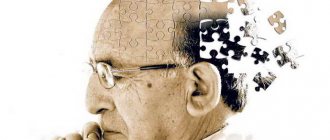Decoding the research results
The results of interpretation of Echo EG of the brain in adults and children do not differ.
The procedure is performed by a sonologist. Normally, the examination consists of three bursts, which are called complexes. The initial burst is a signal generated by ultrasound. Ultrasound is reflected from the bone tissue of the skull, skin and brain tissue. The median burst (M-echo) is a complex that is obtained when ultrasound comes into contact with the structures of brain tissue located between the two hemispheres.
The final burst is a signal that comes from the tissues of the cranial bones and the dura mater of the brain on the other side of the probe. The connection between these three complexes is projected onto the monitor screen and represents a graph with axes. The specialist prints the results on paper and begins decoding.
Evaluation of indicators
The data decryption is as follows:
- M-echo. Such a signal usually occupies a middle position between two bursts. A displacement of 1.5 mm will be considered normal. If the indicator is higher, then you need to undergo additional diagnostics. After a stroke, a shift of more than 5 mm indicates the hemorrhagic nature of the disease. If there is no signal at all or it is no more than 2.5 mm, the disease is ischemic in nature.
- Burst from the third cerebral ventricle. Splitting or expansion of this indicator indicates intracranial hypertension.
- M-echo pulsation. Indicators should not exceed 10-30%. If they are higher, this may indicate hydrocephalus of the brain.
- SI (mid-sellar index). For adults, the norm will be 3.9-4.1 and above. If the results are lower, this indicates increased intracranial pressure.
Rice. 1. Schematic representation of normal echoencephalograms: at the top - a frontal section of the head with ultrasound sensors located in the temporal regions (A, B), echoencephalograms are located below (A - right, B - left); SS - midline structures, M - M-echo, ES - echo signal from various non-median structures of the brain, NK - initial complex, CC - final complex; Normally, distance a on the echoencephalogram obtained when installing the sensor on the right is equal to distance b on the curve obtained when installing the sensor on the left.
Rice. 2. Schematic representation of echoencephalograms with a space-occupying formation in the right hemisphere of the brain. In case of pathology (a space-occupying lesion in the right hemisphere of the brain is shaded), distance a on the right (upper) curve is increased due to the displacement of the midline structures of the brain, and the direction of displacement of the M-echo is opposite to the localization of the pathological focus.
Other results
Electroencephalography contains several more indicators:
- Third ventricle index. The norm is 22-24 points. If the result is less, this is a sign of hydrocephalic syndrome.
- Medial wall index. The norm is 4-5 points. A higher result indicates intracranial hypertension.
Each examination, be it Echo-EG, ultrasound or ECG, has errors. Only a doctor can interpret the results. After identifying the origin of the disease, he will prescribe the necessary treatment or additional diagnostics.
The essence of the study
The human brain plays a major role in the functioning of the entire nervous system. A slight malfunction in the functioning of this organ can lead to disturbances in the coordination of the human body. A thorough examination will help identify the causes of the disease.
Echoencephalography of the brain is a reliable and accessible method of research presented in medicine. The procedure is absolutely painless. It can be done at any age.
Not everyone has an idea about the features of this examination method and where it is carried out. Many people are interested in how this procedure is done and what are the indications for diagnostics.
Echo EG is practically no different from ultrasound (ultrasound). Echoencephalography of the brain or echoencephaloscopy (EchoES) is based on the reflection of ultrasonic waves from the tissues of human organs.
Sensors installed on the patient's head transmit waves to each other, which are reflected from the surface and internal structures of the brain. These waves are converted into an electrical signal, which is recorded by a specialist in the form of an image or diagram on the screen. This method gives an accurate picture of the condition and pathologies of the brain.
Electroencephalography allows you to learn about vascular diseases and the causes of improper cerebral circulation. The method helps to assess the lumen and tone of the veins.
A head echo is a non-invasive type of examination, so it is often used to quickly establish a diagnosis in an emergency. This examination should not be confused with the echocardiography procedure, which is used in heart studies.
Echoencephaloscopy Echo-ES
Echoencephaloscopy (Echo-ES) is a diagnostic examination of the brain for intracranial lesions, based on ultrasound location. This is one of the effective, simple methods of examining patients, especially at the stages of emergency care, when making a preliminary diagnosis, screening examinations and in everyday conditions of practical healthcare.
Synonyms:
Echo-EG is an abbreviation for ECHO-Encephalography. From Greek ēchōecho, encephalon telencephalon+ graphō write, depict) i.e. this is a recording of the echoe of the telencephalon
One-dimensional ultrasound encephalography
By the way, the phrases “Echo-EG of the brain”, “Echo-EG of the head” are not entirely correct, because the term Echo-EG already implies a study of the brain.
Safety
Relevance
It seemed that with the introduction of neuroimaging methods into medicine, the decline of one-dimensional ultrasound encephalography was not far off, however, the uniqueness of the new installations, their complexity in operation, the high threshold of economic accessibility and the availability of these installations only in the leading centers of the country for many years will retain the primacy of Echo-EG among diagnostic tools.
Echo EG is normal
Normally, an echo-encephalogram (Echo-EG) reflects the following basic signals:
1. initial complex
2. M-echo
3. final complex
Echo-EG is normal N – initial complex; M – median echo; K – final complex
The ultrasound signal easily penetrates through the outer tissues of the head, skull bones, brain matter, and at the interface between solid and liquid substances (brain parenchyma and cerebrospinal fluid, blood) it is reflected, and this is what is recorded.
With a properly developed brain, the distance from the superficial tissues of the head to the middle structures is the same on both sides. Accordingly, with pathology this distance changes
The study can also be carried out outside a medical institution, on an outpatient basis, if there is an autonomous power source for the echoencephaloscope.
When performing echoencephaloscopy, the subject can be in either a lying or sitting position.
The doctor stands behind the patient’s head and places the device in front of him.
Gets acquainted with the medical history or collects an anamnesis of the disease.
Examines and palpates the patient's head, paying attention to the presence of asymmetries, skull deformations, subcutaneous hematomas, etc. Applies contact gel or petroleum jelly to the scalp to maintain the necessary acoustic contact.*. Apply contact gel or Vaseline oil to the scalp to maintain the necessary acoustic contact.*
Apply contact gel or Vaseline oil to the scalp to maintain the necessary acoustic contact.*
*Taking into account that air has a very high resistance to ultrasound, before installation the sensors should be generously treated with a contact substance (glycerin or petroleum jelly, special contact gel) to ensure maximum adherence to the tissues of the head.
The study is carried out in two special modes of the echoencephaloscope: Orthogonal projection of the third ventricle and emission mode.
Taking into account the existence of natural asymmetries of the brain, as well as measurement errors, a displacement of no more than 1.5-2 mm should be considered normal.
However, if the presence of even a small displacement (not exceeding the specified values) corresponds to the characteristics of the clinical picture, it is necessary to recommend dynamic observation with repeated echoencephalography or, more preferably, a tomographic study (CT, MRI).
Reasons for displacement:
- Tumors of the cerebral hemispheres
- Parenchymal hemorrhages
- Brain abscesses
Much less often, a displacement of the M-echo is observed in ischemic stroke.
The magnitude of the displacement increases with pathological processes accompanied by perifocal edema. At the same time, it is necessary to remember about the possibility of the existence of volumetric symmetrical pathological foci in both hemispheres (“mirror” hematomas).
When is echoencephalography necessary and why it should not be done?
Echoencephalography of the brain and soft tissues of the skull is prescribed to patients of all ages by neurologists for the primary diagnosis of various brain diseases. It often precedes computed tomography or MR imaging, but can completely replace them if there are contraindications (age, serious condition of the patient, pregnancy, claustrophobia, etc.).
Echoencephaloscopy allows you to analyze the state of the brain, detect foci of pathology in its parts, determine their location and size, and evaluate the nature and characteristics of blood flow in the vessels. It is used when traumatic injuries, hemorrhages, purulent processes, cysts, neoplasms, etc. are suspected, to assess the severity of hydrocephalus, and dynamic monitoring during treatment.
Thus, indications for EchoEG may be:
- Possible ischemia and acute disturbance of blood flow in the brain (infarction, hematoma);
- Vegetative-vascular dysfunction with impaired brain function;
- Symptoms of encephalopathy of any origin;
- Benign and malignant neoplasms;
- Parkinson's disease;
- Unexplained fainting;
- Hydrocephalic syndrome;
- Attacks of nausea not related to the state of the digestive system and food intake;
- Neuroses;
- Perinatal pathology, birth injuries and obstetric care that could harm the soft tissues of the baby’s head and brain;
- Possible congenital malformations of the central nervous system and blood vessels.
Echoencephalography may also be prescribed in case of traumatic brain injury, neck injuries with signs of disorders of the brain and blood vessels (cranialgia, dizziness, signs of intracranial hypertension, etc.).
In pediatric practice, ultrasound is used, carried out through a fontanel that has not yet completely closed - neurosonoscopy. It is possible in the first year and a half of a baby’s life and provides a large amount of information due to the absence of an obstacle in the form of bone tissue in the area of the fontanel. Neurosonography is considered a highly accurate method of visualizing the structures of a child’s brain.
Neurosonographic examination is prescribed for children when:
- Stuttering;
- Enuresis;
- Slowing physical and mental development;
- Sleep pathologies;
- Increased muscle tone, convulsive syndrome;
- Suspicion of intracranial hemorrhage in the pathology of childbirth and the early postpartum period;
- Possible intrauterine infection with the risk of defects of the central nervous system that were not diagnosed during pregnancy;
- Possible congenital vascular pathology.
In pediatrics and neonatology, echoencephalography may be the first and only method that provides all the necessary information to make a correct diagnosis of a child. For children, the main advantage can be considered the safety of ultrasound, which does not harm the immature brain and can be used repeatedly.
Neurosonoscopy is used in the process of dynamic observation and monitoring of treatment results, when there is a need for frequent examinations at short time intervals, and parents of small children do not have to worry about the safety of their child.
When prescribing examinations using other methods for children, specialists are faced with the need for immobilization, which is sometimes difficult to achieve without anesthesia, but any medicinal effect, and especially anesthesia, cannot be called harmless. In this regard, ultrasound compares favorably with MRI. During neurosonography, one of the parents fixes the baby’s head, and the person being examined does not experience pain and therefore can easily endure the manipulation.
What are the contraindications to echoencephalography? This question is of particular interest to parents of young patients who are afraid of harming their baby’s brain by examining him repeatedly at an early age. Perhaps the only good reason for refusing the procedure is the presence of open wounds of the soft tissues of the head; in all other cases, ultrasound examination is considered possible and safe.
Echogenicity
Echogenicity is the ability of tissues and organs to create a visible image during ultrasound examination. Echogenicity is usually assessed subjectively as the perceived brightness of an area on a monitor. Depending on how this area compares to the perceived brightness of the surroundings, there are several degrees of echogenicity:
- Anechoic. The area in the image is completely black and no structure is visible.
- Hypoechogenicity. The area appears darker than its surroundings.
- Isoechogenicity. The area appears about as bright as its surroundings.
- Hyperechogenicity. The area appears brighter than its surroundings.
Although we are talking about more or less subjective findings, they are usually quite reproducible, because The echogenicity of the tissue is usually stable.
It is precisely because of the relative stability of the echogenicity of healthy and some pathologically altered tissues that numerous attempts have been made to use its quantitative assessment as a diagnostic tool or even as a basis for computer diagnostics. To quantify the echogenicity itself, a number of indicators are used, in particular:
- statistical properties of gray gradations as a large data set (mean value, variance, skewness coefficient, etc.) and analysis of the histogram of gray gradations;
- analysis of textural characteristics, most often based on the Grayscale Matrix (GLCM);
- estimation of the fractal dimension of the region.
Study indicators and interpretation of results
An echoencephalogram is a graphic representation of ultrasound signals sent by cerebral structures. The main median complex forms the following indicators:
- M-echo is a conventional midline, in the formation of which the third ventricle, pineal gland and septum pellucidum participate.
- The initial complex indicates the first ultrasound wave sent to the brain.
- The final complex is a signal received from the bone of the skull on the left side.
- Lateral, or lateral, echo signals are recorded between the initial and final complexes and are a reflection of waves from the lateral ventricles.
Doctors prefer to carry out several procedures in a row, as well as monitor the patient over time. This will not only allow you to obtain accurate results and avoid errors, but also monitor changes in the state of the brain as a result of injury or illness.
A neuropathologist or diagnostician specializing in this area deciphers and describes the data obtained. Normally, the distance to the M-echo on both sides is the same, a deviation of no more than 1-2 mm is allowed, and the ripple of the M-signal should not be higher than 30%.
Common pathology:
- CNS injury. Brain contusion in most cases causes a slight displacement of the midline structures (within 3-4 mm) due to transient edema on the side of the injury. With post-traumatic cysts, pronounced lateral signals are recorded.
- Tumors. A significant shift in the midline allows the doctor to suspect a neoplastic process in the brain. It is noteworthy that malignant neoplasms contribute to much greater displacement than benign ones.
- Hydrocephalus. EchoEG shows a large number of lateral signals, bifurcation of the main wave - M-echo.
- Acute cerebrovascular accident, or stroke. With intracerebral hemorrhage there will also be a strong displacement and a significant amount of lateral signals.
When is diagnostics required?
An EEG is necessary if such alarming symptoms appear as:
- Severe headaches;
- Frequent loss of consciousness;
- Dizziness for no apparent reason;
We talked about the main causes of dizziness in this article - https://promigreni.com/golovokruzhenie/prichiny.html.
- Insomnia;
- Decreased concentration, lack of attention;
- Regular attacks of nausea;
- Noise in ears;
- Sudden loss of balance.
A diagnostic procedure is carried out if such pathological phenomena and processes are suspected as:
- Traumatic brain injuries;
- Cervical injuries;
- Increased intracranial pressure;
Read more about the main causes of intracranial pressure in children.
- Tumors developing in the cranial cavity;
- Blood flow disorders in the brain;
- Hydrocephalus;
In the video, neurologist Mikhail Moiseevich Shperling explains what to do in case of a head injury:
- Brain abscess;
- Pituitary adenoma;
- Neurotic diseases;
- Brain tuberculosis;
- Parkinson's disease;
- Concentration of pus in the brain cavity.
Read the article telling us what a pituitary adenoma is - what causes it, how it appears and why it is dangerous.
EEG for children
In childhood, this procedure is prescribed if the child has:
- Sleep disturbances are observed;
- There have been head contusions and there are suspicions of open or closed craniocerebral injuries;
- There are neurotic disorders, manifested in stuttering, nervous tics;
- Hyperactive behavior with attention deficit;
Pediatrician Andrei Petrovich Prodeus tells more about the causes of stuttering in children:
- Increased muscle tone;
- Physical development is slow;
- Enuresis or encopresis was detected;
- There is a disease and an assessment of the effectiveness of the treatment is required.
Echo ECG of the brain makes it possible to identify pathological processes and changes that occur in brain tissue, namely:
- The degree of dysfunction of the ventricles of the brain;
- Presence of foreign bodies, cysts;
- The degree of tumor growth;
- Formation of hematomas.
Definition of pathologies
Echo Eg allows you to identify a large number of pathologies. Other advantages of this method are the absence of side effects, safety, and no age restrictions.
During pregnancy, women are prescribed this diagnostic measure aimed at studying all the necessary parameters of the fetus.
It is mandatory to study the state of the brain. It develops normally if the test shows that the hemispheres of the brain are symmetrical and externally resemble butterfly wings.
In this case, the conclusion will contain the indication “the butterfly symptom is present.”
There are a number of differences between procedures aimed at studying the state of the brain.
This event differs from EEG - electroencephalography.
The latter is carried out to study the brain by recording its bioelectrical activity. It is performed to determine the rhythm, frequency and amplitude of brain biopotential waves.
What is the difference between reg and eeg? Read the detailed article.
Carrying out the electroencephalography procedure
REG (rheoencephalography) - allows you to assess the condition of the blood vessels of the brain and their main parameters.
MRI, unlike Echo Eg, is aimed specifically at identifying tumors and changes in brain tissue.
It is important to note that when diagnosing minimal disorders of brain function, MRI is the best option. Because Echo Eg is not very accurate in terms of identifying small pathological foci. Since Echo Eg is not very accurate in terms of identifying small pathological foci
Because Echo Eg is not very accurate in terms of identifying small pathological foci.
Follow-up diagnostics
Despite the fact that a head echo is a fairly accurate diagnosis, a specialist can only draw preliminary conclusions based on it. Making an accurate diagnosis is the task of the attending physician, who relies not only on the results of EchoCG, but also on other studies, as well as on the patient’s medical history.
Only additional methods, test results and studies prescribed by the doctor can confirm or refute the preliminary diagnosis received from the Echo EG specialist.
Echoencephalography is an innovative and highly informative method of examining the head. There are no contraindications to its use, it is painless and absolutely safe. Therefore, when prescribing this form of diagnosis by a doctor, you should not ignore the procedure.
Indications of echo-EG of the brain
Echoencephaloscopy is indicated when alarming symptoms appear: migraine, fainting, dizziness of unknown etiology, loss of balance, tinnitus, nausea and vomiting, prolonged insomnia, decreased concentration, constant fatigue.
People in whom the attending physician suspects the occurrence of lesions and other processes in the brain need diagnosis: intracranial hypertension, cervical injuries, traumatic brain injuries, circulatory disorders in the brain, tumors (benign and malignant) in the skull, hydrocephalus, idiopathic parkinsonism syndrome , tuberculosis, pituitary adenoma, brain abscess, neurotic diseases, meningitis or encephalitis.
The specialist gives a referral for Echo-EG to young children when there is: sleep disturbance (drowsiness or insomnia), neurotic disorders, nervous tics, stuttering, head injuries, hyperactive behavior in which the child constantly demands attention, increased muscle tone, enuresis, slowdown in physical development, encopresis.
It is advisable to conduct a study when a diagnosis has already been made to assess the effectiveness of the course of therapy.
Indications for the study include: concussion, memory impairment, neurotic reactions, feeling of lack of oxygen, fainting, nausea not associated with eating, and others.
The examination allows you to detect dangerous lesions in the brain: hematomas, tumors, foreign bodies, neoplasms, cysts, disruption of the functioning of the ventricles of the brain.
Advantages of the diagnostic method:
- safety;
- the possibility of performing the procedure on children, pregnant women and even the elderly;
- absence of adverse reactions and complications after manipulation;
- minimum of contraindications (echoencephalography is not done only if the patient has open wounds on the head, since sensors cannot be installed because of them);
- reliability and accuracy of graphic images;
- Not only the midline structures of the brain are examined, but also the periosteal space of the skull.
Echo-EG is prescribed to pregnant women to examine fetal parameters. The condition of the baby’s brain must be studied. The results of the procedure can be called positive if the brain hemispheres in the picture are symmetrical and look like butterfly wings.
What the examination shows - video
Echoencephalography of the brain helps to identify many pathologies, as well as deviations from the norm. That is why analysis is often used to diagnose ailments, especially since it is not dangerous and does not require complex manipulations. Physicians, surgeons and neurologists, as well as a number of other specialists, can refer you to it.
During ECHO EG, you can observe various processes and identify violations. You can see if there are cysts, abscesses and tumors, as well as foreign bodies in the skull. It will be possible to verify the absence of negative changes in the tissues of the central nervous system, or, on the contrary, confirm violations.
If necessary, you can analyze the state of the cerebral ventricles and directly pay attention to their functioning. A head echo allows you to see the uniformity of tissue texture and check for the presence of hematomas.
If there is a pathology, then with the help of an examination you can determine its location and stage of development. In situations where it is important to assess the rate of progression of the disease, as well as the response to treatment, you will need to undergo frequent ECHO of the brain. Such an analysis helps to monitor the patient’s condition, which allows you to select the most effective therapy.
The main advantage of the procedure is that it is safe for people of any age. Therefore, it is carried out for both infants and pensioners. In this case, no punctures are made, and the body is not exposed to radiation.
The procedure does not even use contrast agents, so there will be no allergic reaction. The session itself will not cause negative feelings in the patient; no special preparation is even required.
After undergoing ECHO EG, a person can immediately return to their normal life. The examination itself is permitted in almost all cases, and the only contraindication is the presence of open wounds on the human skull. The procedure itself is not expensive - it has a fairly low price compared to other computer diagnostic methods.
As for accuracy, it is satisfactory, but it is not suitable for minor or rare diseases . In difficult situations, you will have to undergo more expensive and complex examinations; even invasive methods are possible.
Pros and cons of EEG
The electroencephalography technique occupies a leading place in the list of methods for assessing the work of the brain. The procedure is available in almost any outpatient clinic, is low-cost compared to magnetic resonance and computed tomography, and takes no more than 15-20 minutes.
EEG allows us to identify the very initial stages of pathological processes in brain tissue. The method is safe, harmless, has no effect on ability to work, and does not require special preparation for the study.
Another positive aspect of the technique is the possibility of performing it on patients in a coma or in serious condition. The procedure is painless, EEG can be performed on both adults and children, even infants.
A relative disadvantage of EEG is the need to remain motionless during the study, but this requirement is generally applicable to many studies in neurology.
When you contact a neurologist with complaints of epileptic seizures, and after performing an EEG, you may not find signs of epilepsy on the encephalogram. Indicators that appear on the encephalogram are not observed in all patients, but only during convulsive seizures. There are cases when signs of epilepsy can be noted on the encephalogram without clinical signs - in the complete absence of seizures. In these cases, it is necessary to further examine the patient using other methods.
Preparation for the procedure and its implementation
One- and two-dimensional echoencephalography does not require the patient to prepare independently. All he needs to do is visit the diagnostic room at the appointed time. Before starting the examination, the diagnostician will ask him to remove from his head any accessories that may interfere.
During the process, the doctor installs an ultrasound sensor in certain areas of the head. To ensure high-quality contact, a contact gel is first applied to them. This prevents air from entering and causing interference. The sensor is placed:
- above the ear canals;
- near the outer edges of the eyebrow arches (at the temples);
- behind the ears at a distance of four to five centimeters.
By sending ultrasound signals, the sensor catches them in reflected form and transmits them to the device, which displays them on the monitor in the form of a graphic image similar to the teeth of an electrocardiogram.
When carrying out the procedure in a two-dimensional format, the sensor is not rearranged sequentially - it is moved along the surface of the head, providing an image of the slice in a horizontal plane along the line of its movement. An image of the formations located at this level is displayed on the screen. The duration of the procedure is no more than 15 minutes.
More about diagnostics
Many people are interested in what it is – an echoEG of the main organ of the central nervous system. Another question that concerns patients is how it affects their health.
The essence of the method
The examination is completely safe - it is no coincidence that it is performed even on infants.
The method is based on the difference in surfaces and tissue density from which directed waves return. Thus, healthy skin and subcutaneous tissue have one reflected signal, a more liquid cyst or hematoma has another, gray matter has a third, etc. The difference between them gives the specialist a reliable idea of possible disorders in the patient.
Doctor's actions
EchoEG is carried out with a sensor equipped with a special plate capable of both sending and receiving data. It is attached to the temple above the ear. First, the sides of the head are lubricated with gel. The patient usually lies or sits during these manipulations
An important condition is that the person should not move.
When the plate is deformed, ultrasound is generated and directed to the tissue elements. Returning, the wave is transformed into an electrical signal and reflected on the monitor. The entire procedure takes a maximum of 15 minutes.
Modes
EchoEG is performed both in one-dimensional M-mode and in two-dimensional (ultrasound). In the first case, a graph with several rises is visible on the screen, showing the relationship between brain structures. Two-dimensional diagnostics gives a flat picture and is used for children.
Types of impulses
The graphic image that appears on the monitor after the examination consists of 3 sets of signals: initial, final and the most important - median, or M-echo
- The initial complex is reflected high-frequency pulses showing the location of bone tissue and external integument, the hard fibrous membrane of the brain, and muscles located in the sensor’s coverage area. Data is captured at the left edge of the monitor.
- The final one is a set of impulses pushed off from another inner wall of the skull and its covers. The data is visible on the right side of the screen.
- The median complex is waves reflected from the 3rd ventricle, the transparent septum, and the epiphysis. The distance correlates with the midline of the skull in the sagittal plane. Deviation in M-echoencephalography from the midline indicates pathological displacements in this organ of the central nervous system.
Data decryption
What the monitor screen shows must be interpreted correctly. This is what a neurologist does. As a rule, deciphering the results is based on the components described above. Occasionally additional bursts (lateral echoes) are taken into account.
Decoding begins with an analysis of the median complex. The permissible displacement of the distance from the selected point to 2 other complexes between which it is located is no more than 1-2 mm in adults, and up to 3 mm in children (maximum 5 mm, and ideally the same).
The ripple limits should not exceed 50%. If this happens, the doctor, if there are relevant patient complaints, diagnoses hypertension.
If the midsellar index is less than certain values (“4”, marks 39), this indicates increased intracranial pressure in adults.
EchoEG is also used for indirect diagnosis of the condition of cerebral vessels. The vector of median deviations gives an idea of the location of the lesion.
The accuracy of interpretation of the obtained EchoEG data depends on the professionalism of the neurologist, the depth of probing and the resolution of the echoencephalograph.
Preparation and procedure
As already mentioned, there is no need to perform any special preparatory actions. You can undergo research immediately after it is prescribed by a doctor. But you need to take into account that your head must be clean, so you should take care of this in advance.
Sometimes a doctor may insist that a person stop taking medications. This is not required in all cases, so there is no need to stop taking the medication without permission.
When the procedure is recommended for a baby, it needs to be fed in advance. The study will take some time, so it is important that the baby does not start crying due to hunger. The parent may be asked to hold the baby's head during the ECHO and, if necessary, to calm him down. Otherwise, there are no recommendations; the person will only be required to behave adequately during the study.
Echoencephalography of the brain can be performed both in a supine position and in a sitting position. First, a small amount of gel is applied to the area of the person’s head that needs to be analyzed. This substance is required to eliminate interference and also conduct electrical signals.
After this, the doctor will have to attach the sensor to obtain data through them. They may need to be moved to other areas and this will be done by a specialist. A person just needs to try not to move so as not to knock down the indicators.
It may be noted that ECHO EG of the brain can be carried out in different ways. There are two types that are used for patients:
- Emission. In this case, one sensor will be attached to the area where the signal must penetrate.
- Transmission . The specialist will use two sensors, they will be located on the left and right sides of the head, and the equipment should be at the same level.
The bottom line is that one device will send a signal, and the second must receive it. As a result, it will be possible to obtain the midline of the cranium, and it will be compared with the anatomically correct one. In a situation where a discrepancy is detected, one can suspect a brain injury, the presence of blood clots and some other abnormalities.
As soon as the analysis results are received, the doctor will be able to move on to deciphering the information and draw a conclusion . The doctor will rely on the information that was received at the beginning, in the middle and at the end of the ECHO EG. Thanks to this, it will be possible to examine tissue throughout the entire depth of the skull.
Decoding the research results
An echoencephalogram is a graphical representation of three signals:
- Initial.
- Of course.
- Middle.
The initial complex is a set of reflected high-frequency impulses that show the location of the external tissues of the head (skin, muscles, bones), as well as the fibrous membrane of the brain. The image is fixed in the left corner of the screen.
The final complex is impulses coming from the other wall of the skull. The data is shown in the right corner of the screen.
The median complex (M-Echo) is waves coming from the third ventricle, the transparent septum, and the epiphysis.
Normal EchoEG indicators in an adult:
- The distance between M-Echo signals on both sides should not exceed 2 ml. Otherwise, there is a suspicion of displacement of brain structures.
- The signal from the third ventricle should be uniform. If it changes, intracranial hypertension should be suspected.
- M-Echo pulsation is not higher than 10–30%. An increase in this indicator indicates an excess of cerebrospinal fluid and cerebral edema.
- The distance between pulses must be the same.
- The average sellar index is at least 4.0. A decrease in the indicator indicates intracranial hypertension.
In various pathological processes, echoencephalography data may change as follows:
- brain tumors cause a significant shift in indicators;
- with head injuries, moderate displacements are detected (up to 3 mm);
- post-traumatic cysts are recorded in the form of lateral echo waves;
- hemorrhage is characterized by significant asymmetry;
- with hydrocephalus, the M-Echo expands up to 0.7 cm, and a large number of lateral waves arise;
- cerebral infarction is recorded in the form of a transient dislocation of the midline structures.
EEG
EEG - helps determine pathological activity of the brain
Electroencephalography (EEG) is a method for studying brain activity, used when damage to its structures is suspected. Using EEG, the participation of the central nervous system in pathologies of other organs and systems is also monitored. The study is based on recording electrical impulses emanating from individual areas of the brain.
The analysis obtained during the diagnostic procedure - an electroencephalogram - is a graphic display of the biopotentials of the brain. This is a curved line, thanks to which you can track important parameters of the nervous system. They are called the properties of rhythmicity and make it clear whether parts of the brain work in harmony.
Indications for EEG
- Headaches, dizziness;
- Paroxysmal hemicrania;
- sleep disorders, insomnia;
- mental disorders;
- neuroses;
- delayed speech development, stuttering;
- autism;
- tracking brain development in children;
- poisoning with neurotoxic poison;
- post-stroke condition;
- epileptic or other seizures;
Manifestations of an epileptic attack may vary
- panic attacks;
- coma;
- vegetative-vascular dystonia;
- endocrine diseases;
- hepatic encephalopathy;
- confirmation of brain death.
The EEG is absolutely painless for the patient. He is in a relaxed sitting or lying position, his eyes should be closed. The procedure is carried out both during the day and at night when the patient is sleeping. In this case, the person is allowed to fall asleep naturally or is given sedatives. This EEG is relevant for temporal lobe epilepsy and sleep disorders.
The patient is put on a special headgear, which is equipped with electrodes. They record electrical activity at various points on the head. The results of the analysis are graphs displayed on a computer screen or special paper. The doctor deciphers the encephalogram, determining the presence of mental disorders and their nature.
If necessary, EEG video monitoring is used, when the progress of the study is recorded on a video camera. Indications for the use of this procedure are the need to monitor the patient's anxiety states. Video monitoring is also used to record long-term EEG and to evaluate the study during wakefulness and sleep.
